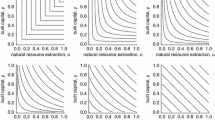Abstract
One of the recurring themes in the sustainability literature has been the extent to which a loss of natural capital can be made up for in welfare terms by an increase in other forms of capital. This issue was raised early on in the debate on sustainability by Pearce and has never really been resolved. This paper is an empirical attempt to measure the degree of substitutability between different forms of capital. A nested CES production function is used to allow flexibility in the estimated elasticities of substitution. Also, within this specification, natural resources and other inputs are combined in different levels of the function, thus allowing for different levels of substitutability. Institutional and economic indicators are also incorporated in the production function estimated. Results show that the elasticities derived from functions involving land resources were generally around one or greater, implying a fairly high degree of substitutability. Furthermore, changes in trade openness and private sector investment have a statistically significant and direct relationship on the efficiency of production and hence on income generation. No statistically significant relationship between income and any of the institutional indicators was found.
Similar content being viewed by others
References
Asheim GB, Buchholz W (2000) The Hartwick rule: Myths and facts’ discussion paper 11/2000. Department of Economics, University of Oslo
Barro R, Lee JW (2000) International data on educational attainment: updates and implications. CID working paper no. 42. Center for International Development, Harvard University
Beck T, Demirgüç-Kunt A and Levine R (1999). A new database on financial development and structure. World Bank Econ Rev 14(3): 597–605
Berndt E and Wood D (1979). Engineering and econometric interpretation of energy-capital complementarity. Am Econ Rev 69: 342–354
Berndt E, Field B (eds) (1981) Modeling and measuring natural resource substitution. MIT Press, Cambridge, MA
Chang K (1994). Capital-energy substitution and the multi-level CES production function. Energy Econ 16(1): 22–26
Chiang AC (1984). Fundamental methods of mathematical economics, 3rd edn. McGraw-Hill Book Company, Singapore
Garofalo A and Malhotra D (1988). Aggregation of capital and its substitution with energy. Eastern Econ J 14(3): 251–262
Greene W (2000). Econometric analysis, 4th edn. Prentice Hall, USA
Griffin J and Gregory P (1976). An intercountry Translog model of energy substitution responses. Am Econ Rev 66: 845–857
Griffin J (1981). Engineering and econometric interpretations of energy-capital complementarity: comment. Am Econ Rev 71(5): 1100–1104
Hamilton K (1995). Sustainable development, the Hartwick rule and optimal growth. Environ Resour Econ 5: 393–411
Hnatkovska V and Loayza N (2004). Volatility and growth. In: Pinto, B (eds) Managing volatility and crises: a practitioner’s guide, pp. The World Bank, Washington, DC
Hudson E and Jorgenson D (1974). U.S. Energy Policy and Economic Growth, 1975–2000. Bell J Econ Manage Sci 5: 461–514
Kang H, Brown GM (1981) Partial and full elasticities of substitution and the energy-capital complementary Controversy, Chapter 5. In: Berndt E, Field B (eds) Modeling and measuring natural resource substitution. MIT Press, Cambridge, MA
Kaufmann D, Kraay A, Mastruzzi M (2005) Governance matters IV: governance indicators for 1996–2004. World Bank Institute working paper. The World Bank, Washington, DC
Kemfert C and Welsch H (2000). Energy-capital-labor substitution and the economic effects of CO2 abatement: evidence for Germany. J Policy Model 22(6): 641–660
Kemfert C (1998). Estimated production elasticities of a nested CES production function approach for Germany. Energy Econ 20: 249–264
Kent A (1972). Optimal growth when the stock of resources is finite and depletable. J Econ Theory 4(2): 256–267
Manne A and Richels R (1992). Buying greenhouse insurance: the economic costs of CO2 emission limits. MIT Press, Cambridge, MA
Mitra T (1978). Efficient growth with exhaustible resources in a neoclassical model. J Econ Theory 17(1): 114–129
Moroney J and Trapani J (1981). Factor demand and substitution in mineral-intensive industries. Bell J Econ 12(1): 272–284
Parks R (1971). Price responsiveness of factor utilization in Swedish manufacturing, 1870–1950. Rev Econ Stat 53(2): 129–139
Pearce DW, Markandya A and Barbier E (1989). Blueprint for a green economy. Earthscan Publications, London
Pearce DW, Atkinson GD and Dubourg WD (1994). The economics of sustainable development. Ann Rev Energy Environ 19: 457–474
Prywes M (1986). A nested CES approach to capital-energy substitution. Energy Econ 8: 22–28
Solow J (1987). The capital-energy complementarity debate revisited. Am Econ Rev 77(4): 605–614
Stiglitz JE (1974a). Growth with exhaustible natural resources: efficient and optimal growth paths. Rev Econ Stud 41: 123–137
Stiglitz JE (1974b). Growth with exhaustible natural resources: the competitive economy. Rev Econ Stud 41: 139–152
Wagner G (2004) Environmental macroeconomics bibliography. Available at: http://www.gwagner.net/ work/environmental_macroeconomics.html
World Bank (2005)World development indicators. The World Bank, Washington, DC
World Bank (2006) Where is the wealth of nations? The World Bank, Washington, DC
Author information
Authors and Affiliations
Corresponding author
Rights and permissions
About this article
Cite this article
Markandya, A., Pedroso-Galinato, S. How substitutable is natural capital?. Environ Resource Econ 37, 297–312 (2007). https://doi.org/10.1007/s10640-007-9117-4
Published:
Issue Date:
DOI: https://doi.org/10.1007/s10640-007-9117-4




